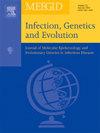Narrowing the region of candidate genes that control the development of protoscoleces of Echinococcus multilocularis in the mouse liver
IF 2.6
4区 医学
Q3 INFECTIOUS DISEASES
引用次数: 0
Abstract
Alveolar echinococcosis is a zoonosis caused by the larval stage of Echinococcus multilocularis. In previous studies, QTL analysis using C57BL/6 N (B6) and DBA/2 (D2) which differ in susceptibility suggested the presence of genes on chromosome 1 that control protoscolex development. In this study, we constructed several congenic mice with different chromosome 1 regions substituted to confirm the presence of responsible genes and to narrow down the regions where the responsible genes exist.
Five lines of third-generation congenic strain were constructed and infection experiments were conducted. The results showed that the development of protoscolex was seen in the two lines, resulting to narrow-down the responsible region between 69.4 cM and 70.67 cM. There were 18 genes having different SNPs and 10 genes having amino acid substitutions between B6 and D2 within this region.
Infection experiments with third-generation of congenic mice succeeded in narrowing down the chromosomal region determining protoscolex development, resulting to reduce the number of candidate genes. The identification of the gene responsible for protoscolex development will contribute to the control of E. multilocularis infection.
缩小小鼠肝脏中控制多房棘球蚴原头节发育的候选基因区域。
肺泡棘球蚴病是一种由多房棘球蚴幼虫期引起的人畜共患病。在以往的研究中,利用易感性不同的C57BL/6 N (B6)和DBA/2 (D2)进行QTL分析表明,1号染色体上存在控制原头节发育的基因。在本研究中,我们构建了几只替换了不同1号染色体区域的同源小鼠,以确认责任基因的存在,并缩小责任基因存在的区域。构建了5株第三代同源菌株,并进行了侵染实验。结果表明,原头节发育在两系中均有发生,负责区域缩小到69.4 cM ~ 70.67 cM之间。在该区域内,有18个基因存在不同的snp, 10个基因在B6和D2之间存在氨基酸替换。用第三代同源小鼠进行感染实验,成功地缩小了决定原头节发育的染色体区域,从而减少了候选基因的数量。原头节发育相关基因的鉴定将有助于多房棘球蚴感染的控制。
本文章由计算机程序翻译,如有差异,请以英文原文为准。
求助全文
约1分钟内获得全文
求助全文
来源期刊

Infection Genetics and Evolution
医学-传染病学
CiteScore
8.40
自引率
0.00%
发文量
215
审稿时长
82 days
期刊介绍:
(aka Journal of Molecular Epidemiology and Evolutionary Genetics of Infectious Diseases -- MEEGID)
Infectious diseases constitute one of the main challenges to medical science in the coming century. The impressive development of molecular megatechnologies and of bioinformatics have greatly increased our knowledge of the evolution, transmission and pathogenicity of infectious diseases. Research has shown that host susceptibility to many infectious diseases has a genetic basis. Furthermore, much is now known on the molecular epidemiology, evolution and virulence of pathogenic agents, as well as their resistance to drugs, vaccines, and antibiotics. Equally, research on the genetics of disease vectors has greatly improved our understanding of their systematics, has increased our capacity to identify target populations for control or intervention, and has provided detailed information on the mechanisms of insecticide resistance.
However, the genetics and evolutionary biology of hosts, pathogens and vectors have tended to develop as three separate fields of research. This artificial compartmentalisation is of concern due to our growing appreciation of the strong co-evolutionary interactions among hosts, pathogens and vectors.
Infection, Genetics and Evolution and its companion congress [MEEGID](http://www.meegidconference.com/) (for Molecular Epidemiology and Evolutionary Genetics of Infectious Diseases) are the main forum acting for the cross-fertilization between evolutionary science and biomedical research on infectious diseases.
Infection, Genetics and Evolution is the only journal that welcomes articles dealing with the genetics and evolutionary biology of hosts, pathogens and vectors, and coevolution processes among them in relation to infection and disease manifestation. All infectious models enter the scope of the journal, including pathogens of humans, animals and plants, either parasites, fungi, bacteria, viruses or prions. The journal welcomes articles dealing with genetics, population genetics, genomics, postgenomics, gene expression, evolutionary biology, population dynamics, mathematical modeling and bioinformatics. We also provide many author benefits, such as free PDFs, a liberal copyright policy, special discounts on Elsevier publications and much more. Please click here for more information on our author services .
 求助内容:
求助内容: 应助结果提醒方式:
应助结果提醒方式:


